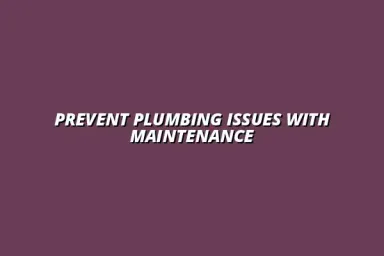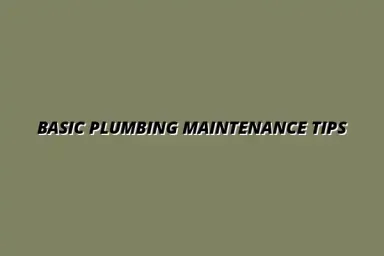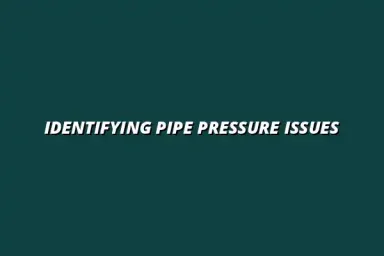Identifying Signs of a Collapsed Pipe in Your Yard
When it comes to maintaining a healthy yard, understanding the signs of a collapsed pipe is essential. A well-functioning drainage system is vital for preventing water from pooling or causing damage to your landscape. If you're not attentive, minor issues can turn into significant problems, so let's dive into how to spot these early warning signs! If you're experiencing issues with slow draining sinks, you might want to check out this guide on fixing a slow-draining sink as a similar underlying issue could be at play.
Understanding the Importance of Pipe Integrity
The integrity of your drainage pipes plays a crucial role in the overall health of your yard. A strong drainage system prevents water accumulation, which can lead to flooding and erosion. Keeping an eye on your pipes not only protects your property but also ensures your plants and grass receive the right amount of moisture.
In fact, neglecting pipe issues can result in costly repairs and extensive damage. By being proactive, you can maintain a safe and beautiful outdoor space. Let’s explore some common indicators that might point to a collapsed pipe in your yard. Learning how to detect hidden pipe leaks at home can be a valuable skill in preventative maintenance.
Common Indicators of a Collapsed Pipe
Unusual Ground Settling and Sinkholes
One of the first signs of a potential pipe collapse is unusual ground settling. If you notice areas of your yard sinking or forming small depressions, it could mean that the pipes below are failing. Sinkholes can be particularly alarming, as they may suddenly appear and cause serious safety hazards.
Pay attention to how the ground feels underfoot. If it feels soft or spongy in certain areas, this might indicate that water is accumulating beneath the surface. Keeping an eye on these signs can help you catch problems early!
Pooling Water and Unexplained Wet Spots
Another clear sign of a problem is the presence of pooling water. If you find standing water in your yard after a rainstorm or even without recent precipitation, this could signal a drainage issue. Wet spots that seem to appear out of nowhere may be a result of leaking pipes. Understanding the signs and solutions for blocked drains can help you address issues before they become more severe.
- Look for areas where water accumulates regularly.
- Check for muddy patches that seem out of place.
- Observe any persistent dampness that doesn't dry out quickly.
By tracking these signs, you can better understand what might be happening underground and take action before things get worse!
Increased Grass Growth in Certain Areas
Have you noticed some areas of your yard growing greener and lusher than others? Excessive moisture from a collapsed pipe can lead to uneven grass growth. It’s important to identify these patches, as they might indicate that water is seeping into the soil from a broken pipe.
Monitor your lawn for patches that seem to be thriving while others are struggling. This could be a key sign that something is off with your drainage system, so keep your eye out for these green flags!
Strange Odors Around Your Yard
Lastly, if you catch a whiff of foul smells wafting through your yard, it's time to investigate! Unpleasant odors can be a clear indication of sewage leaks or water accumulation, often stemming from collapsed pipes. Not only is this a nuisance, but it can also pose health risks.
Ensure you take any strange smells seriously. It’s better to address these issues sooner rather than later!
Visual Signs of Pipe Failure
Surface Cracks and Distortions
Visible signs of deterioration can also provide clues regarding the integrity of your pipes. Look for cracks or distortions in the ground, particularly near where your drainage pipes are located. These cracks could be a result of soil movement or water pressure caused by collapsed pipes beneath. For more in-depth information on preventing pipe leaks, check out these helpful maintenance tips.
- Inspect the ground for any unusual cracks.
- Notice if sections of your yard seem to bulge or sink.
- Keep an eye on your driveway or sidewalks for similar issues.
By being vigilant about these surface changes, you can gain insights into potential pipe failures!
Unusual Changes in Your Landscaping
Changes in your landscaping can also indicate deeper problems. If certain plants are thriving while others are wilting, it could be a sign of irregular moisture levels caused by a collapsed pipe. Additionally, if your previously flat yard starts to slope or shift, this could mean that piping issues are at play.
Make a note of how your plants are doing and whether your yard’s shape has changed. This awareness can help you catch problems before they escalate!
Preventive Measures and Maintenance Tips
Regular Inspections and Routine Maintenance
Preventing pipe collapse is all about being proactive! Regularly inspecting your drainage system can help catch problems early. Consider scheduling professional checks at least once a year, or whenever you notice any signs that something is off. For those in the Billesley, Birmingham area, you can find a reliable plumber in Billesley, Birmingham to assist with inspections and repairs.
- Look for deterioration signs around your yard.
- Clear any debris from drainage pipes.
- Keep an eye on your landscaping for changes.
Investing time in maintenance will save you money and hassle in the long run!
Choosing the Right Landscaping Practices
Lastly, selecting appropriate landscaping practices can help avoid future pipe collapse. Be mindful of how you plant trees and shrubs, as some species have aggressive root systems that can damage pipes. Additionally, using mulch and ground cover can help retain moisture without overwhelming your drainage system.
Make thoughtful landscaping choices, and you’ll create a beautiful space that also protects your pipes!
Understanding the Causes of Pipe Collapse in Your Yard
When it comes to maintaining a healthy yard, understanding the causes of pipe collapse is crucial. Many factors can lead to deterioration, and recognizing them can help you avoid costly repairs. Whether it’s natural elements or human activities, being aware of these causes empowers you to take proactive measures. Understanding the causes of bursting water pipes can provide further insight into potential problems.
Natural Factors Leading to Pipe Failure
Soil Erosion and Water Saturation
Soil erosion can significantly impact the stability of your pipes. When heavy rains occur, soil can wash away, leading to weakened support around your pipes. Additionally, water saturation can create constant pressure on pipes, increasing the likelihood of leaks or breaks.
- Heavy rainstorms contributing to soil movement.
- Areas with clay soils that retain water longer.
- Gradual soil degradation due to gardening activities.
Tree Root Intrusion and Its Impact on Pipes
Roots from nearby trees are more than just a pretty sight; they can also be a serious threat to your pipes! As roots search for moisture, they can penetrate and invade the pipes, causing blockages and even collapse. This is especially true for older pipes that may already be weakened.
- Species of trees known for aggressive root growth.
- Signs of root intrusion, such as slow drainage.
- Preventive measures like planting trees away from pipes.
Human-Induced Factors Affecting Pipe Integrity
Improper Installation and Material Degradation
Sometimes the problems stem from the start! If pipes are improperly installed, it can lead to significant issues later on. Additionally, the materials used in pipes can degrade over time, especially if they’re not suited for your soil type.
- Common mistakes during installation that should be avoided.
- Types of materials that are more durable.
- Signs that indicate material degradation.
Impact of Heavy Machinery and Landscaping Activities
Have you ever thought about how landscaping can affect your pipes? Heavy machinery used during construction or landscaping can compact the soil, putting undue stress on underground pipes. This pressure can eventually lead to cracks or even complete collapse.
- Types of machinery that pose risks to pipe integrity.
- Best practices for landscaping near existing pipes.
- Signs of pipe damage after construction activities.
Frequently Asked Questions about Collapsed Pipes
What should you do if you suspect a collapsed pipe?
If you notice signs of a collapsed pipe, it’s important to act quickly. First, you should document the signs you've observed, like pooling water or strange odors. Next, contacting a professional plumber for an inspection is the best course of action to prevent further damage. Addressing a leaking water heater requires similar prompt attention from a qualified professional.
- Document any visible signs and their locations.
- Contact a professional plumber for a thorough inspection.
- Follow up on suggested repairs as soon as possible.
How can you prevent future pipe collapses in your yard?
Preventing pipe collapse is about taking proactive steps and staying informed. Regular maintenance and smart landscaping choices can go a long way in maintaining pipe health. Here are some effective strategies to consider:
- Implement regular inspections and maintenance.
- Choose landscaping techniques that protect soil integrity.
- Be mindful of tree placement and root growth.
Final Thoughts on Maintaining Pipe Health
In summary, recognizing the causes of pipe collapse is vital for any homeowner. By understanding the signs and taking preventive action, you can protect your yard and your wallet! Don't hesitate to connect with professionals for regular inspections and maintenance to keep your pipes in good working order.
Remember, staying vigilant now can save you from big headaches later!

 Kiran Almasi
Kiran Almasi

